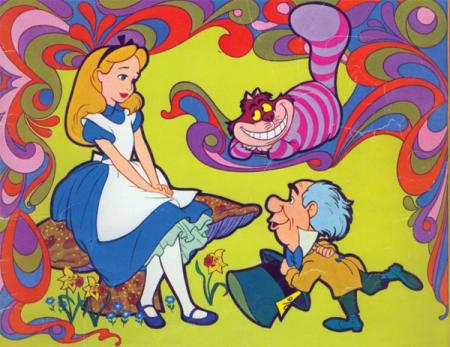Lewis
Carroll (real name Charles Lutwidge Dodgson) was a British author,
mathematician, and Anglican deacon most famous for his children's
novels Alice's
Adventures in Wonderland
and The
Hunting of the Snark
(Cohen). Mathematical
and logic problems are a prominent feature of Carroll's writings. He
also enjoyed creating nonsensical situations and inventing words; the
term “portmanteau”
to describe a made-up combination of two words to create a new one,
was coined because of Carroll's Jabberwocky
poem. In Alice's
Adventures in Wonderland
and Through
the Looking Glass,
Carroll employs paradoxical logic and nonsense in order to create an
atmosphere of wonder, bafflement, and humor in his stories. Several
elements of the books can be related to math problems, including the
deck of card soldiers, the chessboard, and the looking glass.
Both
of Carroll's stories open with Alice entering an inverted or
“opposite” parallel world. In the first book she falls through a
tunnel underground. In the second book she steps through the looking
glass. Both of these represent a transition of reality (and with it
the underpinning rules of logic, maths, and physics, etc.) from the
real world into a fantasy world. Thus most of the logic represented
in Alice in Wonderland is centered around opposites, paradox, and
mathematical symmetries. There are many instances where Carroll
encoded these kind of clever math problems and concepts into his
writing. For example, in The
Annotated Alice
Martin Gardener writes about the geometry forms encoded in the
characters of Tweedledum and Tweedledee, “[they] are what geometers
call 'enantiomorphs,' mirror-image forms of each other. That Carroll
intended this is strongly suggested by Tweedledee's favorite word,
'contrariwise,' and the fact that they extend right and left hands
for a handshake” (Gardener, 231).
Many
math problems in Alice
revolve around logic wordplay and subtle tricks of perception. One of
my favorite quotes is when the Duchess advises Alice, “and the
moral of that is–'Be what you would seem to be'–or, if you'd like
it put more simply–'Never imagine yourself to be otherwise than
what it might appear to others that what you were or might have been
was not otherwise than what you had been would have appeared to them
to be otherwise' (Gardener, 122). While the previous statement is
very difficult to entangle, in terms of logic Carroll is basically
playing with the relationship between “true” and “false”
which is the underpinning of rational logic. By showing the
mirror-image or “enantiomorphic” nature of binary logic, Carroll
is able to create humor through this juxtaposition.
Other
instances of math in Alice often involve physical characters or
places which symbolize math problems. The
chessboard in Through
the Looking Glass
is another symmetrical symbol, made from eight by eight squares, with
eight being the square root of sixty-four, the total number of chess
spaces. Alice moves through these squares like advancing in a chess
game, with the ultimate aim of becoming a Queen. In Alice
there is a living deck of cards, which are often used as examples of
mathematical probabilities. The card soldiers
tend
to run around in a chaotic, perhaps random pattern, at direction of
the Queen. At the end of the trial scene, the end of the first book,
the cards all jump on Alice and she wakes up. Perhaps Carroll is
making a point about the dreamland logic of Wonderland giving way to
reality, and the cards represent the reassertion of the resounding
certainty of mathematical probabilities which are stable in real
world maths.
The
appeal of Alice in Wonderland is at least partially due to the
complexity of mathematical formulations in the books. Carroll does
this is in brilliantly clever, humorous, and subtle ways, by blurring
the lines between chaos and order in the world. Donald Rackin sums
this up nicely in his book Alice's
Adventures in Wonderland and Through the Looking-Glass: Nonsense,
Sense, and Meaning when
he writes,
If
Alice's Adventures in Wonderland is, then, best understood as a
grimly comic trip through the lawless underground that lies just
beneath the surface of our constructed universe, what gives the work
its indisputable relevance to that universe, what keeps the book
itself from becoming formless, inconsistent, hopelessly confusing,
and deeply troubling? The answers to these questions provide a
revelation of the book's literary nature, a probable explanation of
its enormous popularity, and a tentative glimpse at a fundamental
problem of existence in modern culture (Rackin, 37).
Works
Cited:
1.
Gardener, Martin. The
Annotated Alice.
Bramhall House, New York, 1960.
2.
Rackin,
Donald.
Alice's
Adventures in Wonderland and Through the Looking-Glass: Nonsense,
Sense, and Meaning.
Twayne Publishers, New York,
1991.
3. Cohen, Morton N. Lewis
Carroll: A Biography.
Vintage, 1996.















